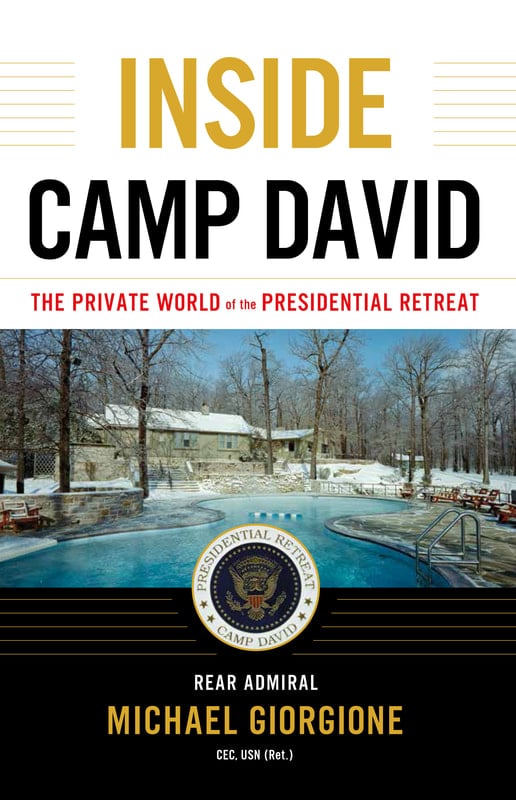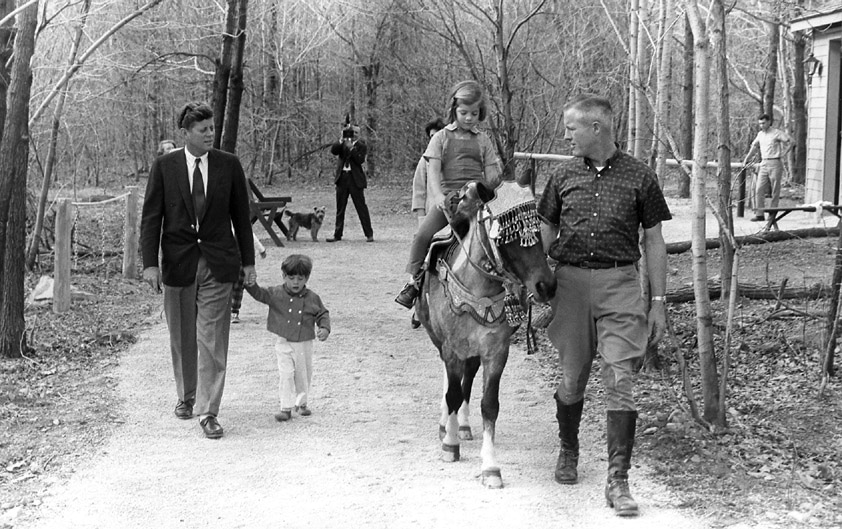If you want to take a very rare journey into the history and workings of one of the most secretive and powerful places on Earth, Retired Navy Admiral Michael Giorgione, a former commanding officer of Camp David brings you right in the front gate.
Giorgione brings forth an amazing inside look of the American presidential retreat Camp David in his book, “Inside Camp David.”

“Inside Camp David” by Rear Admiral Michael Giorgione CEC, USN (Ret.) (Photo courtesy of Rear Adm. Michael Giorgione)
Giorgione gives readers an eye into the private lives of the 13 presidents and their families who have frequented Camp David over its 75-year history through his own experience, along with the experiences of 18 of the 24 Navy Officers who served as commanding officers there. The result provides a picture of what life was like inside Camp David and illuminates the central character of the presidency and America.
Camp David is the country retreat for the President of the United States. It is located in forested hills about 62 miles — a two and a half hour drive — north-northwest of Washington, D.C., in Catoctin Mountain Park near Thurmont, Md.

President Barack Obama walks with staff to Laurel Cabin before the start of a G8 Summit working session at Camp David, Md., May 19, 2012. Walking with the President, from left, are: Chief of Staff Jack Lew; Ben Rhodes, Deputy National Security Advisor for Strategic Communications; Mike Froman, Deputy National Security Advisor for International and Economic Affairs; and National Security Advisor Tom Donilon. (Official White House Photo by Pete Souza)
Giorgione gives us a glimpse into the earliest days of what was to become Camp David. He quotes President Franklin Delano Roosevelt, who first viewed the site of the future presidential retreat and declared, “This is my Shangri-La.” He took a personal interest in every detail of the camp’s development. Every President has left his personal mark since. Invisible to the naked eye is the lock-down security comparable to that of the White House, while providing “the relaxed, woodsy feeling of a summer camp” that some presidents have called “too quiet.”

A chess game between Prime Minister Menachem Begin and U.S. National security adviser Zbigniew Brzezinski in Camp David during the peace negotiations between Israel and Egypt in 1978. (Israel Government Press Office/Released)
The site was established in 1935 by the Works Progress Administration (WPA), and originally named “Shangri-La” by President Roosevelt, but was renamed Camp David in 1953 by President Eisenhower in honor of his grandson. Known formally as Naval Support Facility Thurmont, it is staffed entirely by Navy and Marine Corps officers, NCOs, and enlisted personnel.
Giorgione, a captain during his assignment at Camp David, commanded a staff solely of U.S. Navy and Marine Corps men and women. While members of his staff were carefully selected for this most prestigious assignment, most had no prior experience to conduct the plethora of tasks they were called upon to perform at Camp David. His superior leadership inspired top performance, flexibility, adaptability, and, most importantly, teamwork to meet the many unforeseen emergencies and challenges.

President Kennedy, son John F. Kennedy, Jr., and daughter Caroline Bouvier Kennedy at Camp David, Maryland on March 31, 1963. (Robert Knudsen, White House / John F. Kennedy Presidential Library and Museum)
Giorgione gives us a comprehensive history into the earliest days of what was to become Camp David. He took a personal interest in every detail of the Camp’s development and every U.S. President has left his personal mark since.
The “personal stamp” of what Camp David has meant to each President is evident in Giorgione’s words. It was Franklin Roosevelt’s Shangri-La. To Lyndon Johnson, it “was just another place to work.” John Kennedy found a place to have special fun with his family. Richard Nixon “shaped Camp David to meet his needs, and the camp reflected his moods.” Gerald Ford used the site to nurture his First Lady, Betty, after major surgery. For Jimmy Carter, it was the site of his greatest achievement, the Camp David Accords. For Ronald Reagan, the site was “where he could be a husband and person on his own terms.”

President Lyndon B. Johnson held many conferences at Camp David. Here, he enjoys a light moment while in conversation with Secretary of Defense Robert McNamara and Secretary of State Dean Rusk in March 1965. (Johnson Library/Released)
The camp served as a family retreat for Bush 41. Bill Clinton “found ways to make it fit his personality” and warmed to the camp where he became especially close with the Marines and Sailors stationed there. George W. Bush shared the family love and “spent long hours during the holidays on the phone speaking to the troops overseas.” Barack Obama “came the closest to making it ‘the people’s camp.'”
President Harry Truman was the only president to rarely use Camp David because “his wife called it dull.”

President Bush plays doubles tennis with Chris Evert, David Bates, and Tut Bartzen at Camp David, Aug. 4, 1990.
(George Bush Presidential Library/Released)
Though the camp offers the President and his family an opportunity for solitude and tranquility, it has served as a host to foreign leaders and affairs of state. Far removed from the public and the press, Camp David has hosted and will continue to host some of the world’s most important discussions and decisions among world leaders – from fighting World War II to the Middle East agreement signed in the 1978 Camp David Accords.
There is nothing dull about Camp David, and Giorgione captures the magnitude of this part-office, part-retreat for the world’s most powerful leaders.



